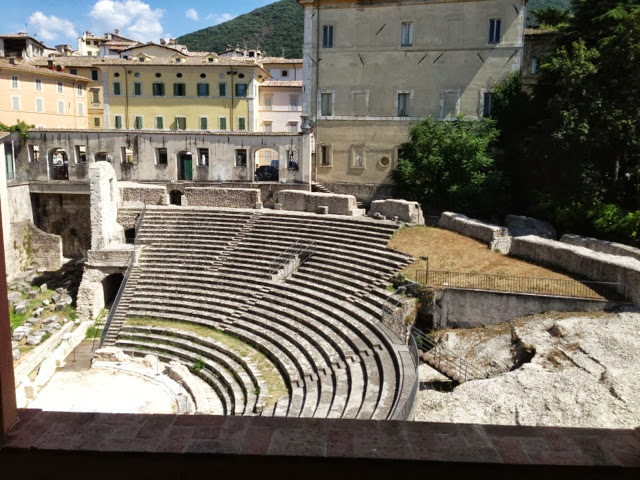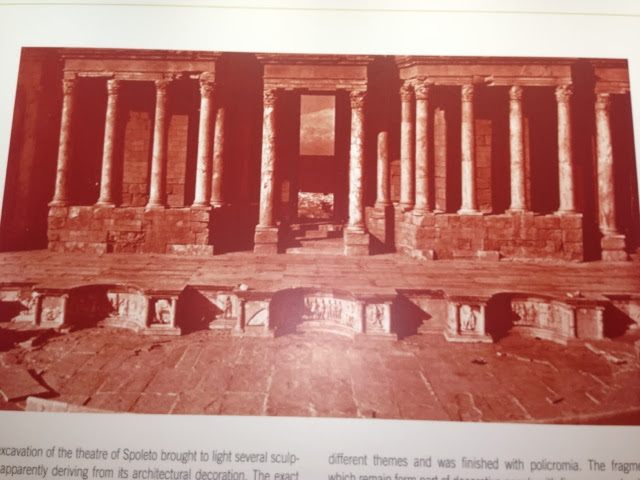You've guessed it - a bit more Roman History.
This time it is the Roman Theatre of Spoleto - a UNESCO World Heritage monument and proof that Spoleto has always been a centre for the arts.
While there are numerous Roman amphitheatres surviving in Italy, France and other parts of the ancient Roman empire, and Spoleto has an amphitheatre too, this is one of the few theatres for dramatic and musical performance that we have found.
Looking down from the current piazza you can see how much excavation was required. The lower level of the monastery (the apricot coloured building with the arches) was at ground level when it was constructed in the 15thC.
The semi-circular area was for the orchestra and musicians. The best seats were at the front with standing room at the rear. An earthquake hit the theatre at one point, shearing it in half; you can see that the seating on the far side was reconstructed in a different manner, using more concrete and less stone - but that was back in Roman times.
The monastery is now the Museum for the Roman Theatre. The theatre building was two stories at the rear (on left of photo). The odd stones on the grass are fragments of the stage area and are placed roughly where they originated. The missing stone was possibly used for building purposes when the abbey was constructed on the Roman foundations, much later - maybe 9thC. The abbey is the ugly grey shape on the right and it is much older than the monastery at the rear. The whole site has always been occupied by religious buildings.
The foundations of the rectangular abbey were also excavated. You can see from the different levels that the abbey was built on top of the theatre's stage, using it as part of the foundations. In fact they have excavated some of the original foundations underneath the old abbey - propping it up, of course.
The theatre was buried for thousands of years with other buildings on top. The current piazza level is behind the wall with the arches and windows in it.
This was the "standing room only" area at the rear, built above little refreshment shops near the exits. It is concrete now because it was reinforced after the earthquake, but would have originally been grass or gravel as it is in the section at the top of the picture.
Part of the main entry and exit corridors for patrons - underneath and at the rear - just as in the arenas built today.
A much rougher stone corridor, in the area damaged by the earthquake and repaired.
The main entrance to the theatre. Musicians and special guests would not enter via the passageway but would walk to the right, along the colonnade .........
... which brought them in via this entrance where they moved either to front row seats or joined the orchestra on the flat semi-circle. The stage was on the level of the low stone wall on the right.
This is what the raised stage of the theatre would have looked like with the orchestra or musicians on the lower level, in front of the patrons. They had mechanical scenery and curtain winders to change "the stage set" as required.
That circular pit on the left is where the mechanisms for controlling scenery and curtains were located. There would have been a matching arrangement on the other side. From this perspective you get a sense of how deep and wide the stage would have been.
During the reign of the Emperor Augustus, the theatre of Spoleto was restored after the earthquake and it decoration enriched - Augustus was a generous patron of the arts and of public buildings. This beautiful white marble statue is a Greek work of the 5th C BC. So it was already 500 years old when it was placed in a niche on an upper level of this theatre.
This travertine mosaic, rescued from a cornice deep within the ancient theatre, depicts a scamillari playing his scabillum during a theatre performance. The instrument is a kind of box made of metal or wood with a horizontal slit inside which a device with a membrane produced a sound when pressed.
On one mosaic the scabillum is also represented as a pair of rectangular tablets connected by a hinge. This particular musical instrument, played with the double flute, was fixed to the foot of the musician to give rhythm to the music and to mimes performed on stage.
In such a show, known as pantomime, musicians would not only accompany the singing of the choir but also guide the gestures of the actors who had to mimic according to the rhythm.
The restored monastery, now the museum is a very handsome building on three levels.
The displays and information were very interesting - this cutaway floor section shows the old Roman foundations on which the monastery was built.
But unfortunately there was no little handout that I could use for notes, so I've had to rely on memory for most of this little saga.

















No comments:
Post a Comment